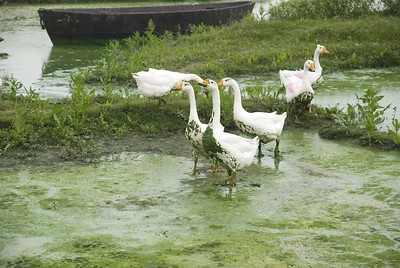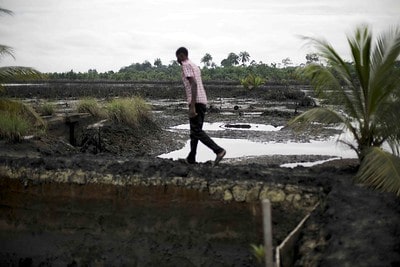Composting Meaning, Stages, Process, and Environmental Impacts
Composting refers to the purposeful accumulation of organic material (or biomass), which is allowed to decompose in order to be used as an additive for soil amendment.
This article discusses composting from a variety of perspectives, as outlined below;
-Composting Meaning: 11 Ways to Define Composting
-Composting Process: The 4 Steps/Stages in the Process of Composting
-Composting of Waste in a Municipal Setting
-Environmental Impact of Composting: How Composting Affects the Environment
Composting Meaning: 11 Ways to Define Composting
Compost is simply a heterogenous mixture comprising of organic matter, which has been accumulated in a pile (called a ‘compost pile’) and allowed to decompose [7]. It is commonly used as an organic soil fertilizer.
In line with the above, composting is simply the act or process of producing compost. The definitions in this section cover various important aspects of composting.
Composting is the act of combining various forms of organic matter such as plant and animal biomass, in a single location, where this organic matter is allowed to decompose.
As the above definition implies, composting is a natural process, which does not place any notable strain on natural resources. In line with the same perspective, it is possible to identify the role of composting in sustainable development, as done below;
Composting is a natural technique of environmental remediation and waste management, whereby organic waste materials are collected, accumulated, and allowed to decompose in such a manner that ensures sustainability of nutrient recycling, and energy conservation.
With regards to the concept of waste management, composting can be defined in terms of its similarity to some of the well-known waste-to-energy techniques, as follows;
Composting is a process of controlled semi-anaerobic digestion of organic matter, which is done to produce compost, a sustainable fertilizer.
Another context which is important to the definition of composting, is soil conservation;
Composting is a soil-conservative measure whereby organic materials are piled-up and allowed to decompose under partially-anaerobic conditions, to produce compost; which is a useful additive for soil amendment.
Because composting is driven mainly by biochemical factors [12], it can also be defined from a biochemical perspective, as follows;
Composting is the practice of controlled microbial biodegradation of heterogeneous organic matter under anaerobic conditions, to produce biochemically-engineered organic fertilizer.
Aside biochemical conditions, physicochemical factors play a role in the composting process. This is portrayed in the following definition;
Composting is the biological degradation of organic materials which have been accumulated and placed under high temperature, low-oxygen and relatively-high humidity conditions.
To provide more clarity, composting can be defined with examples of materials that can be used in the process;
Composting is the accumulation of organic matter in a pile to decompose under favorable physicochemical and biological conditions. An example of composting is the piling of vegetables, food waste, and animal droppings in a confined area where they can biodegrade.
Given that composting is a finite process, the most common stages or phases involved can be included when defining the concept;
Composting is the process of mesophilic alteration, thermophilic alteration, cooling and maturation of organic matter, to produce compost fertilizer [8].
As a means of improving soil fertility, composting plays a role in the efforts to tackle food insecurity [4]. The following definition covers this perspective;
Composting is the improvement of soil fertility and food production through the practice of organic fertilizer preparation from biomass.
Within the same context of waste management, composting can be defined in terms of its role in reducing the amount of waste that is sent to landfills.
Composting is a method of waste diversion whereby the volume of organic municipal soil waste (MSW) that is sent to landfills and other waste disposal sites is drastically reduced, through the anaerobic conversion of this waste to soil fertilizer.
Lastly, composting can be defined in terms of some of its known benefits;
Composting is the sustainable practice of converting organic matter to compost, which serves as a soil amendment that can improve fertility, moisture retention, structure and reduce pests and diseases as well as environmental degradation by chemical fertilizer, in agricultural lands.
Composting Process: The 4 Steps/Stages in the Process of Composting
The four main steps or stages in the process of composting are mesophilic, thermophilic, cooling and curing (or maturation) [5]. They may also be referred to as phases of composting.
1). Mesophilic Phase (Stage 1 in the Composting Process)
Mesophilic phase is the first stage in the composting process, and is characterized by an initial rise in temperature of the organic matter [6].
In some descriptions, the mesophilic stage is said to occur at environmental temperature. While this is not a precise description, mesophilic stage of composting commences at environmental temperature, with the accumulation of organic matter in a compost pile.
After organic matter has been piled-up, mesophilic alteration begins. The temperature range for mesophilic phase of composting lies between 20 and 40°C [9].
During this phase, the temperature and humidity of organic matter in the compost pile, rises. This occurs due to the activities of mesophilic microorganisms or mesophiles. Examples of mesophilic microorganisms include; Staphylococcus aureus, Clostridium kluyveri, Streptococcus pneumoniae, Pseudomonas maltophilia, Streptococcus pyogenes, Listeria monocytogenes, Thiobacillus noyellus, Lactococcus lactis, Listeria monocytogenes, and Salmonella.
These microbes secrete enzymes that alter the biochemical composition of organic matter. Mesophilic alteration in the composting process, usually occurs under aerobic conditions (in the presence of oxygen) and lasts for approximately two days.
Because it marks the onset of temperature rise, the mesophilic phase is also known as the ‘hot phase’ of composting, and involves acidification of substrate with the formation of organic acids. It also usually involves a drop in pH of the organic substrate.
2). Thermophilic Phase (Stage 2 in the Composting Process)
The thermophilic phase of composting is the second stage, which commences immediately after mesophilic alteration, and occurs typically within a temperature range of 40 to 70°C [2].
As temperature rises toward 40°C in the mesophilic phase, mesophiles (the microbes involved) become less active due to unfavorable temperature conditions, as they are adapted to moderate temperatures. From this point, the thermophiles proceed with the composting process.
Thermophiles are microorganisms which are adapted to higher temperatures, and function optimally within an average temperature range of 50-60°C [10]. Some of these organisms are active beyond this average range, at temperatures of 41-122°C or more.
Examples of thermophiles are; Streptococcus thermophilus, Bacillus stearothermophilus, Thermus aquaticus, Alicyclobacillus montanus, and Lactobacilli.
In the thermophilic phase, partially degraded compounds like cellulose and lignin from the mesophilic phase, are subjected to further breakdown by thermophiles, such that their chemical configurations are altered significantly.
Due to the high temperature in this phase, most pathogens in the organic matter are also eliminated [3], alongside toxic compounds that can facilitate environmental degradation.
Thermophilic phase is also referred to as the ‘hygienization phase’ because it involves the elimination of pathogenic organisms and their regenerative components like spores.
3). Cooling Phase (Stage 3 in the Composting Process)
Cooling phase is the third phase in the composting process, where temperature of the organic matter drops back to mesophilic levels, and overall biological activity declines [11].
By this stage, the major aspects of biochemical alteration and biodegradation of the organic matter have already occurred. Thermophilic microorganisms become less active while mesophilic organisms resume their activity. Due to the similarity of this phase to the mesophilic phase, it may be referred to as the mesophilic phase II.
The pH levels at this stage are slightly alkaline, and the carbon-to-nitrogen (C/N) ratio decreases.
Complete degradation also occurs and organic matter is converted to humus, which is highly compatible with the soil. Overall duration of the cooling stage may lie between a few days and some months.
4). Curing/Maturation Phase (Stage 4 in the Composting Process)
Curing phase is the final phase or stage in the composting process, in which gradual decrease in temperature of the compost pile occurs.
There are some criteria which can be used to identify the onset of the curing phase and to distinguish it from the cooling phase.
One of these is the absolute halt in overall temperature rise. While microorganisms may continue to carry out metabolic activities like biodegradation in this phase, their overall degree of activity declines to a negligible level compared to preceding phases of the process.
Also, the biochemical composition and conditions of the organic matter will both remain stable at this stage, and may not be altered by external influences such as the turning of the compost pile and exposure to oxygen.
The overall duration of the curing or maturation stage is usually between three and four weeks, although it may extend far beyond this time frame.
Curing may be considered complete when the temperature of the compost has dropped to a uniform level of 20 to 30°C. At this point, important carbonaceous organic compounds like humic acid may form through condensation reactions.

Composting of Waste in a Municipal Setting
Composting is a sustainable waste management strategy [14].
It can be viewed as a method of municipal waste treatment, which helps to recycle organic waste and convert these materials to useful products.
Composting is effective in a home setting, and can be used to segregate and recycle materials like paper, garden waste, some biodegradable plastics, and food waste.
When gathering the organic waste to form a compost pile, a bin or the ground may be used as collection area.
While a bin may work like a pyrolysis reactor to provide favorable physicochemical conditions for decomposition, an open-ground setting provides more flexibility such as space to turn and aerate the compost pile and optimize the composting process.

Environmental Impact of Composting: How Composting Affects the Environment
Composting is beneficial to the environment in the following ways;
1). Composting Conserves Environmental Resources
Application of compost to the soil improves soil structure and moisture retention [1]. These improvements reduce the rate of moisture and nutrient loss from the soil, thereby conserving environmental resources.
2). Greenhouse Emissions are Reduced
When practiced on a large scale, composting can mitigate greenhouse emissions by reducing addressing open biodegradation and its associated gases like carbon dioxide and methane.
3). Composting Enriches the Soil
Composting produces organic fertilizer, which is a soil amendment that is rich in essential nutrients [13].
Aside facilitating plant productivity, composting drives the growth of microorganisms and other biotic components of the soil ecosystem such as earthworms and insects. These organisms improve the physicochemical and biological characteristics of the soil.
4). Diversion of Waste from Landfills
Through composting, the volume of organic waste that is sent to landfills is reduced.
This reduces the negative environmental impacts of landfill sites, as well as the complexity of waste management as a whole.
5). Mitigation of Environmental Degradation
When compost is used as fertilizer, it may partially or entirely replace chemical fertilizers.
This in turn mitigates the challenges of environmental degradation that are associated with chemical fertilizers, such as soil and water contamination.
Conclusion
Composting is a controlled process whereby organic matter is accumulated and undergoes biodegradation to produce a soil amendment called compost.
The four phases of composting are;
- Mesophilic Phase
- Thermophilic Phase
- Cooling Phase
- Curing/Maturation Phase
Environmental impacts of composting include;
- Resource Conservation
- Reduction of Greenhouse Emissions
- Soil Enrichment
- Diversion of Waste from Landfills
- Mitigation of Environmental Degradation
References
1). Adugna, G. (2018). “A review on impact of compost on soil properties, water use and crop productivity.” Agricultural Science Research Journal Vol. 4(3)(March 2016):93-104. Available at: https://doi.org/10.14662/ARJASR2016.010. (Accessed 28 May 2022).
2). Kuo, S.; Escobar, M. E. O.; Hue, N.; Hummel, R. L. (2004). “Composting and Compost Utilization for agronomic and container crops.” Available at: https://www.researchgate.net/publication/228992161_Composting_and_Compost_Utilization_for_agronomic_and_container_crops. (Accessed 28 May 2022).
3). Lemunier, M.; Francou, C.; Rousseaux, S.; Houot, S.; Dantigny, P.; Piveteau, P.; Guzzo, J. (2005). “Long-Term Survival of Pathogenic and Sanitation Indicator Bacteria in Experimental Biowaste Composts.” Applied and Environmental Microbiology 71(10):5779-86. Available at: https://doi.org/10.1128/AEM.71.10.5779-5786.2005. (Accessed 28 May 2022).
4). McClintock, N.; Diop, A. M. (2005). “Soil Fertility Management and Compost Use in Senegal’s Peanut Basin.” International Journal of Agricultural Sustainability 3(2):79-91. Available at: https://doi.org/10.1080/14735903.2005.9684746. (Accessed 28 May 2022).
5). Meena, A. L.; Karwal, M.; Dutta, D.; Mishra, R. P. (2021). “Composting: Phases and Factors Responsible for Efficient and Improved Composting.” Available at: https://doi.org/10.13140/RG.2.2.13546.95689. (Accessed 27 May 2022).
6). Palaniveloo, K.; Amran, M. A.; Norhashim, N. A.; Mohamad-Fauzi, N.; Peng-Hui, F.; Hui-Wen, L.; Kai-Lin, Y.; Jiale, L.; Chian-Yee, M. G.; Jing-Yi, L.; Gunasekaran, B.; Razak, S. A. (2020). “Food Waste Composting and Microbial Community Structure Profiling.” Processes 8(6):723. Available at: https://doi.org/10.3390/pr8060723. (Accessed 28 May 2022).
7). Paul, J.; Cofie, O.; Josiane, N.; Impraim, R.; Adamtey, N.; Koné, D. (2016). “Co-composting of Solid Waste and Fecal Sludge for Nutrient and Organic Matter Recovery.” Available at: https://www.researchgate.net/publication/304024637_Co-composting_of_Solid_Waste_and_Fecal_Sludge_for_Nutrient_and_Organic_Matter_Recovery. (Accessed 28 May 2022).
8). Pezzolla, D.; Cucina, M.; Proietti, P.; Calisti, R.; Regni, L.; Gigliotti, G. (2021). “The Use of New Parameters to Optimize the Composting Process of Different Organic Wastes.” Agronomy 2021, 11(10), 2090. Available at: https://doi.org/10.3390/agronomy11102090. (Accessed 28 May 2022).
9). Ph, C.; Chennaoui; Salama, Y.; Aouinty; Mountadar, M.; Assobhei, O. (2018). “Evolution of Bacterial and Fungal Flora during In-Vessel Composting of Organic Household Waste under Air Pressure.” Journal of Materials and Environmental Science 9(2). Available at: https://doi.org/10.26872/jmes.2018.9.2.75. (Accessed 28 May 2022).
10). Portillo, M.; Santana, M. M.; Gonzalez, J. M. (2011). “Presence and potential role of thermophilic bacteria in temperate terrestrial environments.” The Science of Nature 99(1):43-53. Available at: https://doi.org/10.1007/s00114-011-0867-z. (Accessed 28 May 2022).
11). Rastogi, M.; Nandal, M.; Khosal, B. (2020). “Microbes as vital additives for solid waste composting.” Heliyon 6(2):e03343. Available at: https://doi.org/10.1016/j.heliyon.2020.e03343. (Accessed 28 May 2022).
12). Say, S.; Chérif, M.; Jedidi, N.; Mahrouk, M.; Fumio, M.; Hassen, A. (2008). “Evolution of Biochemical Parameters During Composting of Various Wastes Compost.” American Journal of Environmental Sciences 4(4). Available at: https://doi.org/10.3844/ajessp.2008.332.341. (Accessed 28 May 2022).
13). Singh, V. K.; Malhi, G. S.; Kaur, M.; Singh, G.; Jatav, H. S. (2022). “Use of Organic Soil Amendments for Improving Soil Ecosystem Health and Crop Productivity.” Ecosystem Services: Types, Management and Benefits, Nova Science Publishers, USA. Available at: https://www.researchgate.net/publication/358770318_Use_of_Organic_Soil_Amendments_for_Improving_Soil_Ecosystem_Health_and_Crop_Productivity. (Accessed 28 May 2022).
14). Taiwo, A. M. (2011). “Composting as A Sustainable Waste Management Technique in Developing Countries.” Journal of Environmental Science and Technology 4(2). Available at: https://doi.org/10.3923/jest.2011.93.102. (Accessed 28 May 2022).


